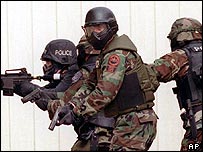Death raises concern at police tactics
By Matthew Davis
BBC News, Washington
The recent killing of an unarmed Virginia doctor has raised concerns about what some say is an explosion in the use of military-style police Swat teams in the United States.
Armed with assault rifles, stun grenades - even armoured personnel carriers - units once used only in highly volatile situations are increasingly being deployed on more routine police missions.

Dr Salvatore Culosi Jr had come out of his townhouse to meet an undercover policeman when he was shot through the chest by a Special Weapons and Tactics force.
It was about 2135 on a chilly January evening. The 37-year-old optometrist was unarmed, he had no history of violence and displayed no threatening behaviour.
But he had been under investigation for illegal gambling and in line with a local police policy on "organised crime" raids, the heavily armed team was there to serve a search warrant.
As officers approached with their weapons drawn, tragedy struck. A handgun was accidentally discharged, fatally wounding Dr Culosi.
Two months on, investigations into the incident are still continuing, a delay which Dr Culosi's family says is compounding the "horror and burden of it all".
Salvatore Culosi Sr, the dead man's father, told the BBC: "I never knew him to carry so much as a pocket knife so it bewilders me how a detective could spend three months investigating my son and not know he is a pussy cat.
"If anything comes out of this it must be that another family does not experience this pain and anguish for absolutely no reason.
"Policy needs to change so these kinds of accidents never occur again."
'Excessive force'
Peter Kraska, an expert on police militarisation from Eastern Kentucky University, says that in the 1980s there were about 3,000 Swat team deployments annually across the US, but says now there are at least 40,000 per year.
"I have no problem with using these paramilitary style squads to go after known violent, armed criminals, but it is an extreme tactic to use against other sorts of suspects," he said.
Mr Kraska believes there has been an explosion of units in smaller towns and cities, where training and operational standards may not be as high as large cities - a growth he attributes to "the hysteria" of the country's war on drugs.
"I get several calls a month from people asking about local incidents - wrong address raids, excessive use of force, wrongful shootings - this stuff is happening all the time," he adds.
Every wrongful death of a civilian, or criminal killing of a police officer, fuels the complex and emotive argument over the way the United States is policed.
Those who reject criticism of the use of Swat teams argue that the presence of the units actually prevents violence through the credible threat of overwhelming force.
John Gnagey, executive director of the National Tactical Officers Association, told the BBC: "What we find is that when Swat teams go out, shootings go down.
"We don't see it as escalating anything. We see it as reducing violence."
The NTOA rejects Mr Kraska's figures and says the actual number of deployments is far lower, but says there is a need for national training standards.
An NTOA study of 759 Swat team deployments across the US, found half were for warrant service and a third for incidents where suspects had barricaded themselves in a building - 50 were for hostage situations.
When criminology professor David Klinger looked at 12 years of data on Swat teams in 1998, he also found the most common reason for calling out teams was serving warrants, but that the units used deadly force during warrant service only 0.4% of the time.
Recruitment video
Last year the Los Angeles Police Department (LAPD) commissioned music video director JC Barros to make them a 10-minute film - To Protect and Serve - that would "get young men and women excited" about a career with the force.
More action film than recruitment video, it follows two LAPD officers who - in one day - capture a robbery suspect, are first on the scene when a gun-toting man takes a woman hostage, mediate a fight, and help to find a young kidnap victim.
Along the way they are supported by colleagues from bike patrol, K-9 dog teams, air support and, of course, the Swat team.
But Mr Kraska sees such initiatives as reflecting a changing culture of police work.
"These elite units are highly culturally appealing to certain sections of the police community. They like it, they enjoy it," he says.
"The chance to strap on a vest, grab a semi-automatic weapon and go out on a mission is for some people an exciting reason to join - even if policing as a profession can - and should - be boring for much of the time.
"The problem is that when you talk about the war on this and the war on that, and police officers see themselves as soldiers, then the civilian becomes the enemy."



No comments:
Post a Comment